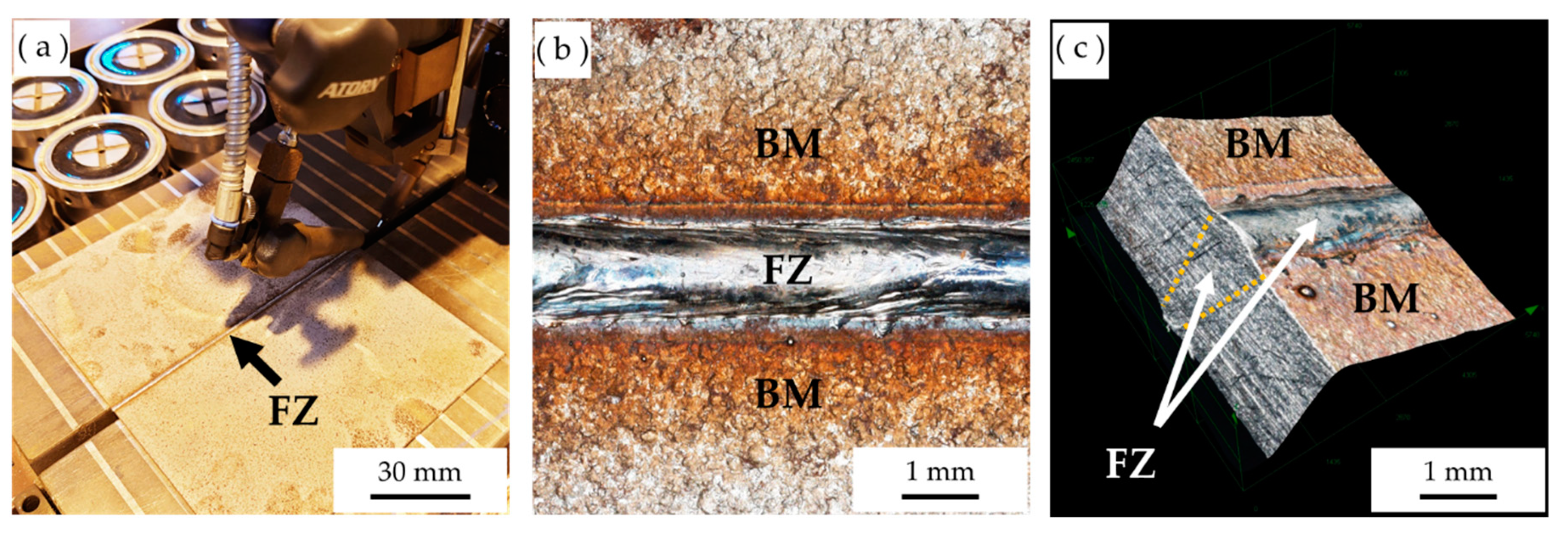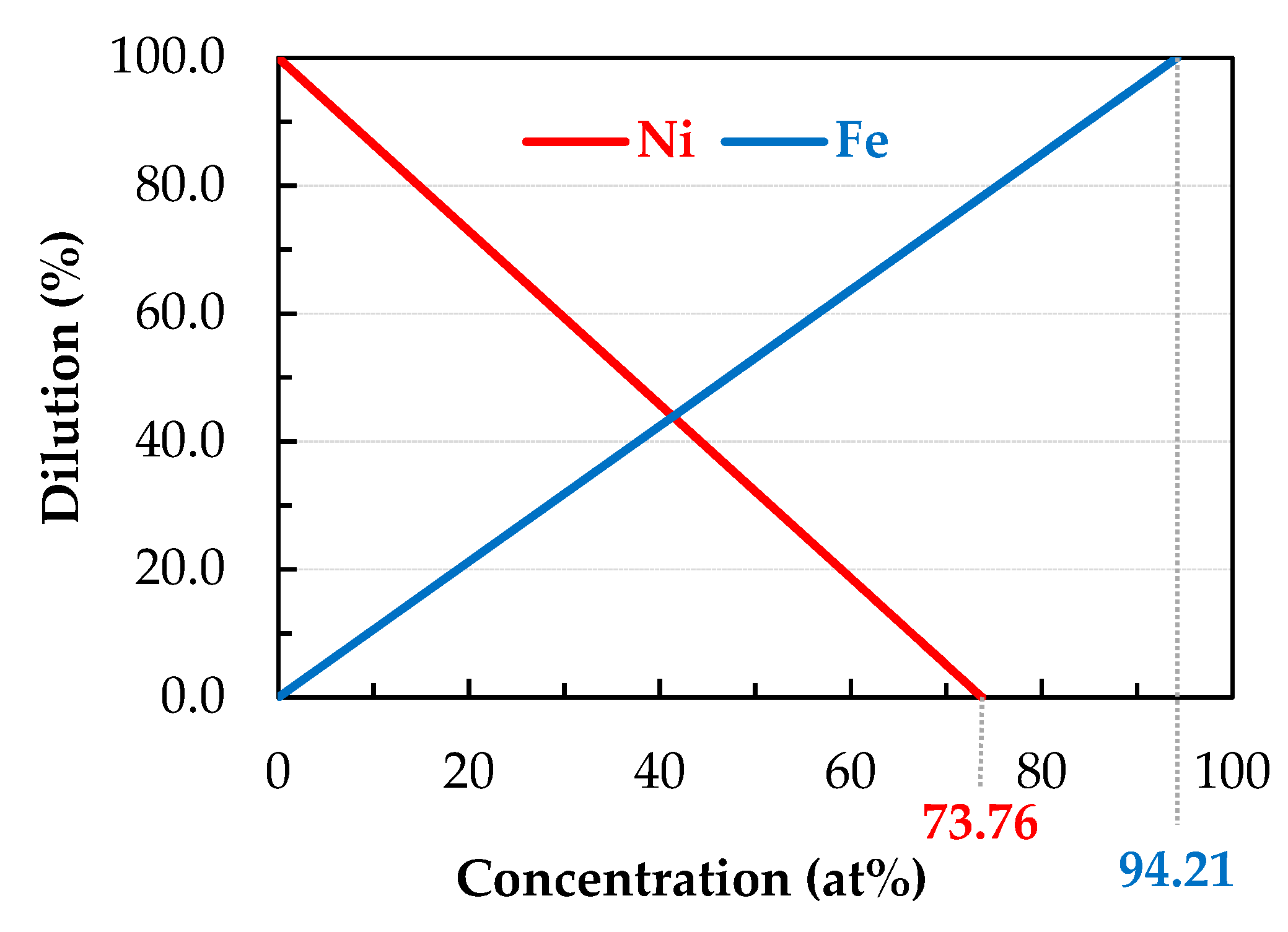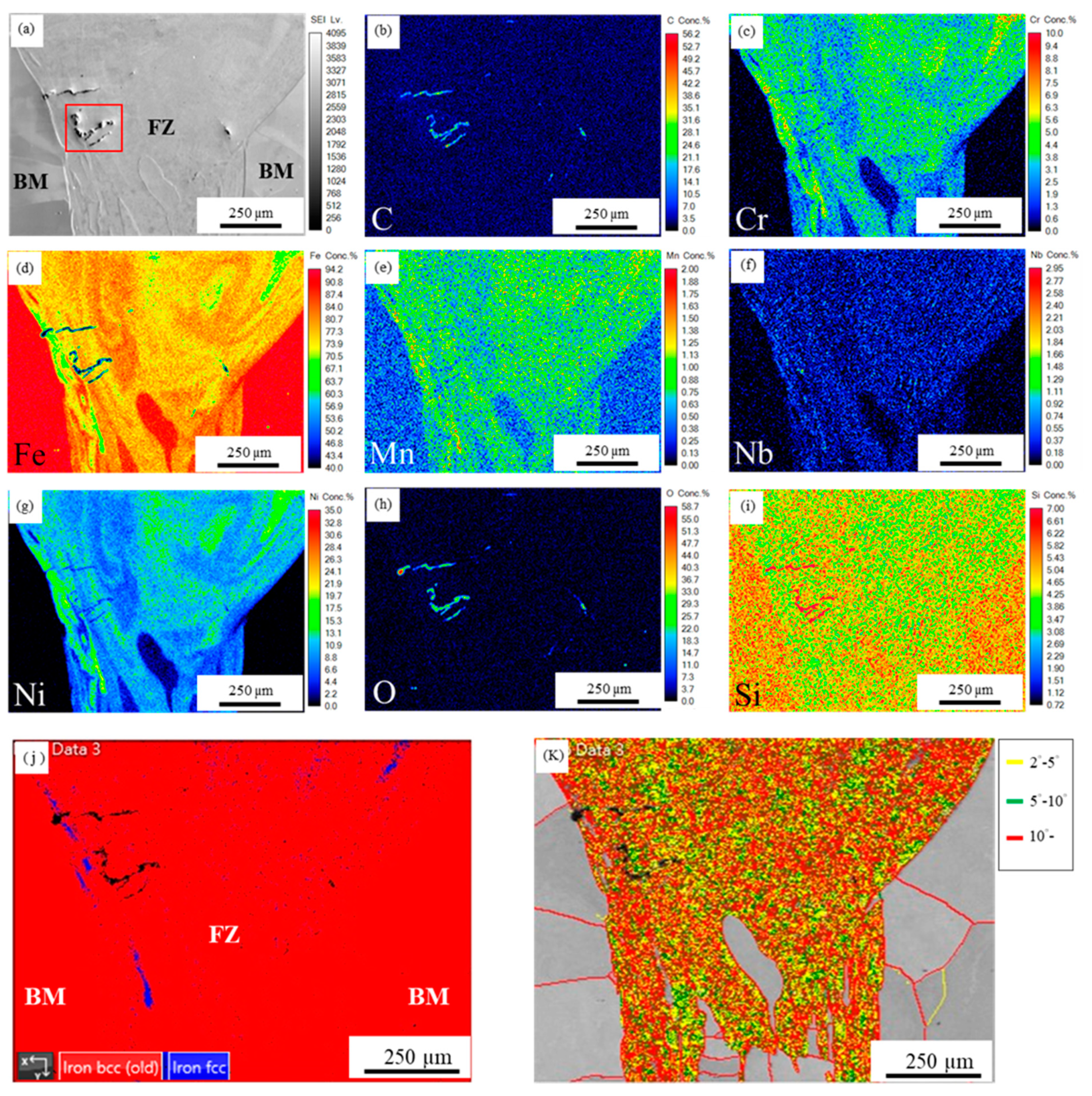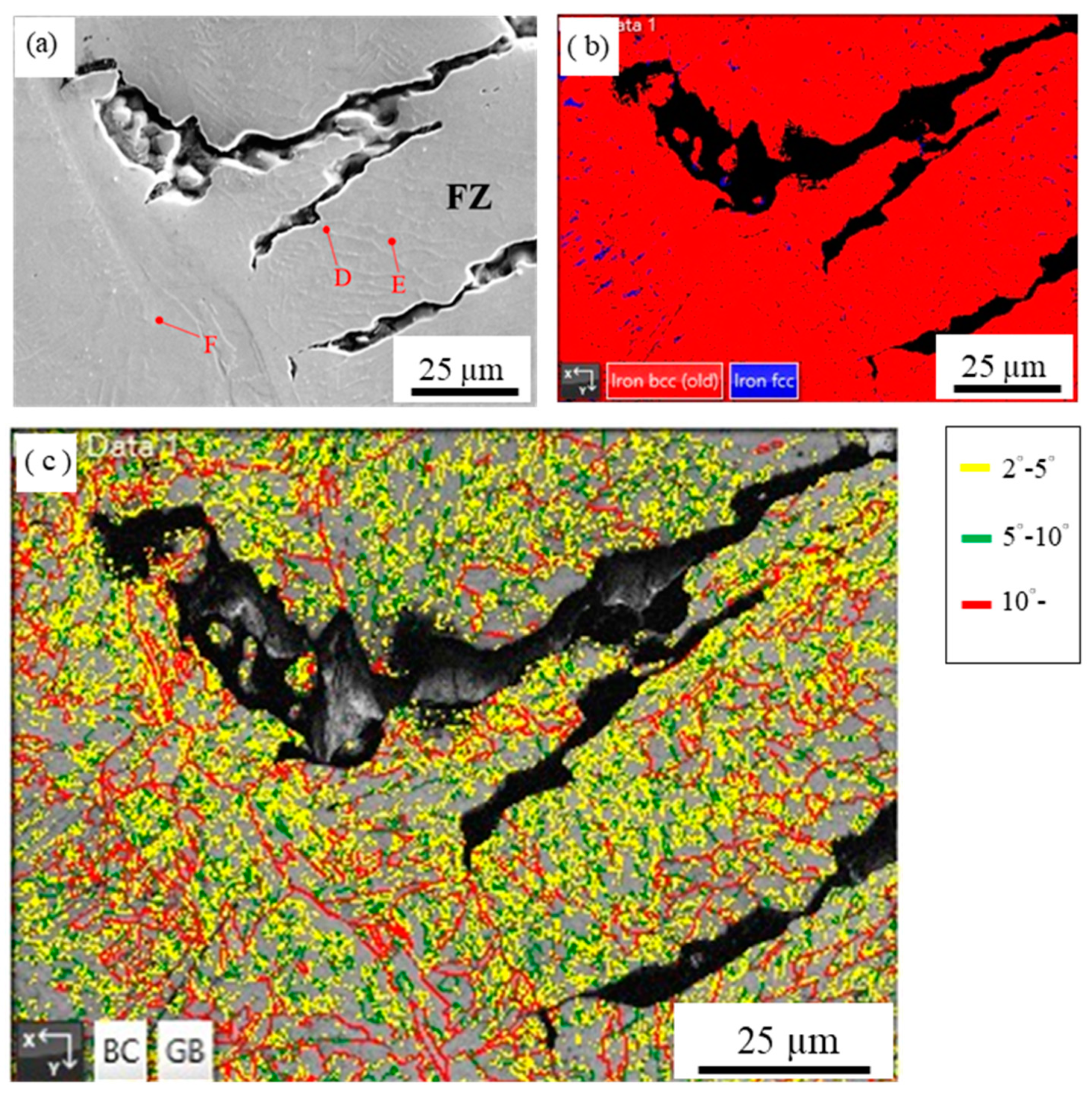The Dilution Effect in High-Power Disk Laser Welding the Steel Plate Using a Nickel-Based Filler Wire
Abstract
:1. Introduction
2. Material and Experimental Procedures
3. Results and Discussion
3.1. Laser Weldment with 3.0 m/min IN82 Wire Feeding Rate
3.2. Laser Weldment with 1.2 m/min IN82 Wire Feeding Rate
3.3. Dilution and Microstructural Evolution of FZ
4. Conclusions
- The microstructure of the FZ is not homogeneous at the macroscopic scale due to incomplete mixing of the weld pool during laser welding. The FZ is composed of austenite, ferrite and BCC structure depending on the dilution of the FZ.
- For the specimen with a 1.2 m/min wire feeding rate, a lower amount of Ni-based IN82 filler was introduced into the weld pool, and the dilution of the FZ is between 65% and 100%. The BCC structure with high density boundaries dominates the entire FZ. There are ferrite grains in the bottom portion of the FZ, and its dilution is close to 100%.
- For the specimen with a 3.0 m/min wire feeding rate, the dilution of the FZ ranges between 50% and 90%. Part of the filler melt is trapped on the top of the weld pool, and solidified into the stable austenite alloyed with a Ni concentration above 15 at%. There are huge blocky/banded austenite and BCC structure at a macroscopic scale due to incomplete mixing of the weld pool in laser welding. Additionally, interdendritic austenite is also observed next to the BCC structure at a microscopic scale formed in the final solidification stage of the FZ.
- There are hot cracks initiated/propagated along interdendritic austenite as well as in the blocky/banded austenite free of boundaries. Boundaries, especially for high-angle ones, in the BCC structure retard hot crack propagation in the FZ.
- The dilution of the FZ in the laser welded butt joint can be obtained by using the WDS quantitative chemical analyses of Fe or Ni concentrations. The methodology proposed in the study shows potential to obtain the dilution of any specific location in the FZ for industrial application in the future.
Author Contributions
Funding
Institutional Review Board Statement
Informed Consent Statement
Data Availability Statement
Acknowledgments
Conflicts of Interest
References
- Goncalves, J.L.; de Mello, J.D.B.; Costa, H.L. Wear in cold rolling milling rolls: A methodological approach. Wear 2019, 426, 1523–1535. [Google Scholar]
- He, H.; Liu, Y.; Yang, Q.; Wang, X.C.; Wang, S.; Wang, Q.N. Symmetry variable taper work roll technology for silicon steel profile control in hot strip mills. Ironmak. Steelmak. 2020, 47, 587–595. [Google Scholar] [CrossRef]
- Wang, R.; Bai, Z.H.; Du, J.C.; Wang, Y.X.; Cui, Y.Y.; Guo, Z.S.; Song, Z.F. Comprehensive tension setting optimisation technique for a cold rolled strip during continuous annealing. Ironmak. Steelmak. 2018, 45, 523–527. [Google Scholar] [CrossRef]
- Hao, K.D.; Gao, M.; Zhang, C.; Wu, R.; Zeng, X.Y. Achieving continuous cold rolling of martensitic stainless steel via online induction heat treatment. Mater. Sci. Eng. A 2019, 739, 415–426. [Google Scholar] [CrossRef]
- Orta, A.H.; Kayabasi, I.; Senol, M. Prediction of mechanical properties of cold rolled and continuous annealed steel grades via analytical model integrated neural networks. Ironmak. Steelmak. 2020, 47, 596–605. [Google Scholar] [CrossRef]
- Kozhevnikov, A.V.; Smirnov, A.S.; Kozhevnikova, I.A.; Antonov, P.V.; Zhilenko, S.V.; Aralov, A.I. Investigation of self-oscillations and the development of a procedure of stabilization of the process in a continuous mill for strip cold rolling. Metallurgist 2020, 64, 770–779. [Google Scholar] [CrossRef]
- Pawar, S.; Sahoo, S.; Mukhopadhyay, G. Failure analysis of weld joint of high strength quality steel sheets in cold rolling mill. Eng. Fail. Anal. 2019, 103, 392–399. [Google Scholar] [CrossRef]
- Hao, K.D.; Gao, M.; Zhang, C.; Wu, R.; Zeng, X.Y. Cold-rolling performance of non-equilibrium martensitic stainless steel produced by laser-arc hybrid welding. J. Mater. Process. Technol. 2019, 267, 359–365. [Google Scholar] [CrossRef]
- Gao, Q.Z.; Liu, Z.Y.; Li, H.J.; Zhang, H.L.; Jiang, C.C.; Hao, A.M.; Qu, F.; Lin, X.P. High-temperature oxidation behavior of modified 4Al alumina-forming austenitic steel: Effect of cold rolling. J. Mater. Sci. Technol. 2021, 68, 91–102. [Google Scholar] [CrossRef]
- Konovalov, S.; Osintsev, K.; Golubeva, A.; Smelov, V.; Ivanov, Y.; Chen, X.; Komissarova, I. Surface modification of Ti-based alloy by selective laser melting of Ni-based superalloy powder. J. Mater. Res. Technol. 2020, 9, 8796–8807. [Google Scholar] [CrossRef]
- Geng, Y.; Konovalov, S.V.; Chen, X. Research status and application of the high-entropy and traditional alloys fabricated via the laser cladding. Prog. Phys. Met. 2020, 21, 26–45. [Google Scholar] [CrossRef]
- Viňáš, J.; Brezinová, J.; Brezina, J.; Maruschak, P.O. Structural and mechanical features of laser-welded joints of zinc-coated advanced steel sheets. Mater. Sci. 2019, 55, 46–51. [Google Scholar] [CrossRef]
- Raghawendra, P.S.S.; Gáspár, M. Investigation of metallurgical and mechanical properties of laser beam welded and post-weld heat treated DP1400 steel. J. Mater. Eng. Perform. 2021, 30, 1703–1710. [Google Scholar]
- Viňáš, J.; Brezinová, J.; Sailer, H.; Brezina, J.; Sahul, M.; Maruschak, P.; Prentkovskis, O. Properties evaluation of the welded joints made by disk laser. Materials 2021, 14, 2002. [Google Scholar] [CrossRef] [PubMed]
- Choi, J. Characterization of a Yb:YAG disk laser line welder for ultra-thin steel strip in industrial cold-rolling mill. Lasers Eng. 2019, 42, 15–29. [Google Scholar]
- Indimath, S.S.; Shunmugasundaram, R.; Balamurugan, S.; Dutta, M.; Gudimetla, S.K.; Kant, K. Online ultrasonic technique for assessment of mash seam welds of thin steel sheets in a continuous galvanizing line. Int. J. Adv. Manuf. Technol. 2017, 91, 3481–3491. [Google Scholar] [CrossRef]
- Lippold, J.C. Welding Metallurgy and Weldability; John Wiley & Sons: New York, NY, USA, 2015. [Google Scholar]
- Kou, S. Welding Metallurgy, 2nd ed.; John Wiley & Sons: New York, NY, USA, 2003. [Google Scholar]
- Lee, S.H. A hot cracking on dissimilar metal weld between a106Gr.B and A312 TP316L with buttering ERNiCr-3. Metals 2019, 9, 533. [Google Scholar] [CrossRef] [Green Version]
- Wu, W.; Tsai, C.H. Hot cracking susceptibility of fillers 52 and 82 in alloy 690 welding. Met. Mater. Trans. A 1999, 30, 417–426. [Google Scholar] [CrossRef]
- Toth, T.; Krasnorutskyi, S.; Henselm, J.; Dilger, K. Electron beam welding of 2205 duplex stainless steel using pre-placed nickel-based filler material. Int. J. Press. Vessel. Pip. 2021, 191, 104354. [Google Scholar]
- Massalski, T.B. Binary Alloy Phase Diagrams, 2nd ed.; ASM International: Materials Park, OH, USA, 1992. [Google Scholar]
- Cheng, T.C.; Yu, C.; Yang, T.C.; Huang, C.Y.; Lin, H.C.; Shiue, R.K. Microstructure and impact toughness of offshore steel. Arch. Met. Mater. 2018, 63, 167–172. [Google Scholar]
- Wahba, M.; Mizutani, M.; Katayama, S. Single pass hybrid laser-arc welding of 25 mm thick square groove butt joints. Mater. Des. 2016, 97, 1–6. [Google Scholar] [CrossRef]
- Bandyopadhyay, K.; Panda, S.K.; Saha, P.; Baltazar-Hernandez, V.H.; Zhou, Y.N. Microstructures and failure analyses of DP980 laser welded blanks in formability context. Mater. Sci. Eng. A 2016, 652, 250–263. [Google Scholar] [CrossRef]








| Location | Chemical Compositions (at%) | Dilution * (%) | Structure (Location) | ||||||||||
|---|---|---|---|---|---|---|---|---|---|---|---|---|---|
| C | Co | Cr | Fe | Mn | Nb | Ni | O | Si | Ta | Ti | |||
| A | 1.1 | 0.2 | 0 | 94.5 | 0.3 | 0 | 0 | 0.1 | 3.8 | 0 | 0 | --- | Ferrite (BM) |
| B | 2.2 | 0.1 | 5.0 | 70.1 | 1.7 | 0.9 | 16.2 | 0 | 3.7 | 0.1 | 0 | 74/78 | Austenite (FZ) |
| C | 2.2 | 0.1 | 2.8 | 81.6 | 0.9 | 0.3 | 8.6 | 0.1 | 3.3 | 0 | 0.1 | 87/88 | BCC (FZ) |
| D | 1.1 | 0.1 | 3.1 | 78.5 | 0.5 | 0.2 | 10.2 | 0.1 | 6.1 | 0 | 0 | 83/86 | BCC (FZ) |
| E | 1.5 | 0.1 | 3.1 | 82.0 | 0.5 | 0 | 8.8 | 0.1 | 3.8 | 0 | 0 | 87/88 | BCC (FZ) |
| F | 1.3 | 0.1 | 2.2 | 84.3 | 0.4 | 0.2 | 6.3 | 0.1 | 5.1 | 0 | 0 | 89/91 | BCC (FZ) |
Publisher’s Note: MDPI stays neutral with regard to jurisdictional claims in published maps and institutional affiliations. |
© 2021 by the authors. Licensee MDPI, Basel, Switzerland. This article is an open access article distributed under the terms and conditions of the Creative Commons Attribution (CC BY) license (https://creativecommons.org/licenses/by/4.0/).
Share and Cite
Chiang, M.-F.; Lo, T.-Y.; Chien, P.-H.; Chi, C.-H.; Chang, K.-C.; Yeh, A.-C.; Shiue, R.-K. The Dilution Effect in High-Power Disk Laser Welding the Steel Plate Using a Nickel-Based Filler Wire. Metals 2021, 11, 874. https://doi.org/10.3390/met11060874
Chiang M-F, Lo T-Y, Chien P-H, Chi C-H, Chang K-C, Yeh A-C, Shiue R-K. The Dilution Effect in High-Power Disk Laser Welding the Steel Plate Using a Nickel-Based Filler Wire. Metals. 2021; 11(6):874. https://doi.org/10.3390/met11060874
Chicago/Turabian StyleChiang, Ming-Feng, Tzu-Yuan Lo, Ping-Hui Chien, Chih-Hsien Chi, Kai-Chun Chang, An-Chou Yeh, and Ren-Kae Shiue. 2021. "The Dilution Effect in High-Power Disk Laser Welding the Steel Plate Using a Nickel-Based Filler Wire" Metals 11, no. 6: 874. https://doi.org/10.3390/met11060874







